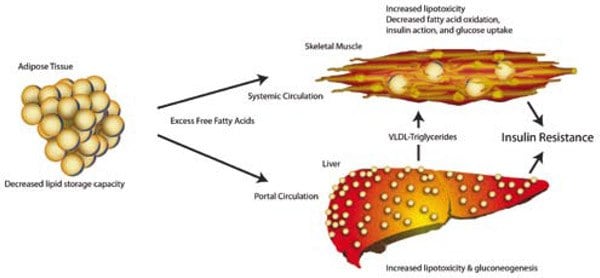肥胖是胰岛素耐受发展过程中公认的风险因素。肥胖与非脂肪组织中脂质沉积增加,以及随后的胰岛素敏感性下降有关。目前,脂肪堆积增加导致胰岛素耐受和代谢综合征的机制尚不完全清楚。
肥胖可能引起体内炎症状态,导致炎症细胞因子生成量增加,从而影响胰岛素敏感度。研究表明,胰岛素耐受和2型糖尿病患者的促炎细胞因子 IL-6 和 TNF-α 水平升高,与这一理论的判断一致。也可能由于脂肪组织产生的激素可能失调,导致脂肪因子生成量增加,从而导致胰岛素耐受。
第三种理论则考虑了脂肪组织储存脂质的能力。该理论假设个体在脂肪组织中储存脂质的能力存在一个设定的上限。超过此限制时,过量脂质会溢出到血浆中,导致血浆游离脂肪酸和甘油三酯水平升高。这会导致这些分子在骨骼肌和肝脏等非脂肪组织中的吸收和储存量增加。非脂肪组织中的脂质异位储存可能引起脂质诱导毒性(脂毒性),导致代谢紊乱。脂毒性还可能造成 2 型糖尿病发展过程的胰腺 β 细胞损失。
脂毒性理论得到了一些研究支持——这类研究采用过量的长链饱和脂肪酸与血清白蛋白复合,培养细胞。在这些研究中,以剂量依赖性方式诱导细胞凋亡,并通过高糖处理强化。脂毒性理论的进一步证据来自对全身或部分脂肪组织丧失的脂质营养不良患者的研究。这些脂质储存能力下降的个体通常会出现严重的胰岛素耐受、血脂异常和脂肪肝。

肥胖引起胰岛素耐受的脂肪膨胀理论推断脂肪组织储存脂质的能力存在上限。达到这个极限时,过量脂肪酸会溢出到血液中,异位储存在骨骼肌和肝细胞中。这种异位储存会导致脂毒性和胰岛素耐受。
胰岛素耐受相关的激素、细胞因子和脂肪因子
脂肪组织是分泌多种激素、细胞因子和脂肪因子的内分泌器官。这些生物活性肽和蛋白质可影响多种代谢过程,包括胰岛素耐受性。
参与脂肪酸释放的酶
脂肪组织的胰岛素耐受能力导致摄入的循环游离脂肪酸减少,脂肪酶水解的储存甘油三酯量增加,上述作用的最终结果就是导致循环游离脂肪酸增加。

高饱和脂肪饮食会增加患 2 型糖尿病的风险。
脂质和脂肪酸测定试剂盒和试剂
脂肪组织的胰岛素耐受能力导致摄入的循环游离脂肪酸减少,脂肪酶水解的储存甘油三酯量增加,上述作用的最终结果就是导致循环游离脂肪酸增加。
材料
如要继续阅读,请登录或创建帐户。
暂无帐户?